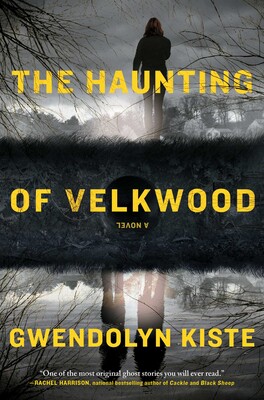They say you can never go home again. For Talitha Velkwood and her two former best friends Brett and Grace, that expression holds an even darker poignancy and accuracy. Their childhood homes lie on a short block stretch of neighborhood now infamously known as the Velkwood Vicinity, named after Talitha’s family, who first moved into one of the residences constructed there. One night decades ago, the block disappeared behind an impenetrable misty cloak; only the three girls managed to get out just prior. All the residents left behind are presumed dead, including Talitha’s mother and little sister, Grace’s boyfriend, Brett’s mother and abusive step-father, and Enid, a strange, bullied girl who served as a fourth, unofficial, sometimes-friend of the surviving trio.

Since the incident, many – scientists, officials, occultists – have tried to pass through the inexplicable barrier that enwraps the neighborhood block, both directly and indirectly through technology. But the anomaly has only permitted one to pass: Grace, who returned and spent one night behind the veil before returning and refusing to discuss anything, suffering a mental collapse and self-imposed institutionalization. Neither Brett nor Talitha have even attempted to go back, instead spending the last twenty years distancing themselves physically and mentally from that past, the publicity it brought, and a haunting unspoken trauma linked to it. The close friendship they held with one another has withered. Though they survived, it feels as if they have not been able to experience any true life since that fateful night.
But then a researcher with special government approval to enter the closed-off borders of the Velkwood Vicinity comes to Talitha requesting her to help and attempt to return. Talitha initially wants no part of it, until she learns that the researcher has managed to get the first quasi-clear drone shots from within, and she sees one of those pictures: a shot of her childhood home. In one window, the faint and blurry form of her little sister.
The Haunting of Velkwood is an interesting take on the haunted house trope, one that blurs the lines between who are the living and who are the ghosts and expands the supernatural milieu from a building or property to an entire community block. With this physical broadening there is also a genre broadening into the more metaphysical realms of cosmic horror. Kiste, a Bram Stoker Award winning horror author, demonstrates profound abilities in establishing moods of gothic, creepy, terror. She also imbibes her protagonist Talitha with the psychological and emotional trials that accompany these genre staples of a haunting. Though The Haunting of Velkwood contains strong threads of plot in terms of past secrets to discover and an ultimate conclusion to the nature of the Velkwood anomaly, the novel is primarily character driven with its revelations of Talitha and Brett and their ultimate personal fates.
However, the most interesting character of the novel may be Enid, for her eccentricities, her precise nature, the social complexities of her relationship with the other characters, and her link to the supernatural plot. Within the story she’s almost the equivalent of a young witch – a girl who is respected, feared, envied, enigmatic, inspiring, and despised. I wish Kiste had developed Enid’s character even more. The best moments come through flashback scenes that are textually integrated with moments in Talitha’s present that trigger the recollections. These shifts in time and space can be jarring for the reader, as for Talitha, but I quickly began to appreciate and enjoy that sort of integration.
Where I found The Haunting of Velkwood to falter more is in the ultimate resolution to the novel and the suspension of disbelief I found myself needing for the concept of this Velkwood bubble. I found it hard to believe that the government wouldn’t take a stronger and more direct (if clandestine) interest in this phenomenon than it seemed to, particularly as things begin to change as Talitha goes back in. Additionally, the magic involved in the creation of the anomaly and the magic involved at the novel’s end, and the explanations of the anomaly’s nature seem to just exist because that’s the way the story needs them to be.
Nonetheless, what I found interesting the novel beyond its gothic ingenuities and strength of atmospheric writing were the themes that the plot seemed molded to present. Those themes are mostly closely related to the character-driven nature of The Haunting of Velkwood, the journey of Talitha and Brett. These two close friends, lovers, learn to face difficult trauma and overcome it, in large part by forgiving themselves and one another, and by learning to let go of things imperfect but out of their hands. Another theme that resonates is the collective ability of a community to cause great horrors by refusing to acknowledge or confront immediate evil, because it’s simply easier to ignore it. This theme directly ties into the matter of haunting perspective that Kiste brings up in the novel: are residents of Velkwood the ghosts haunting the three girls, or are the three girls the ghosts who are haunting the residents of Velkwood? Or is that road into Velkwood a two-way street? Kiste’s new novel is worth reading for just these sorts of questions and how effectively she frames them in new ways within gothic horror.







